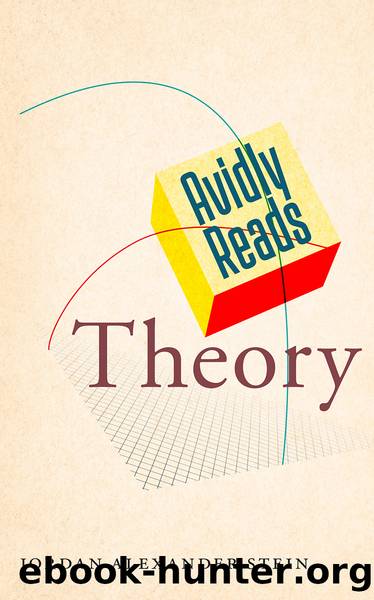Avidly Reads Theory by Jordan Alexander Stein;

Author:Jordan Alexander Stein; [Stein, Jordan Alexander]
Language: eng
Format: epub
Tags: LIT000000 Literary Criticism / General
Publisher: New York University Press
Judy! zine, page 20 (Courtesy Andrea Lawlor)
According to the kind of academic perspective from which theory is usually studied, itâs easy enough to imagine that the work with Dreyfus and Rabinow is Foucaultâs real work and that his time with Wade and Stoneman was a diversion. The mechanisms of academic knowledge transmission (what gets recorded, what gets published, what qualifies a person for tenure) would seem to reinforce the pointâas, by the way, do Foucaultâs biographers (and if you donât believe me, check which proper names get indexed). But such a point pulls as much against Foucaultâs corpus of thought as it does away from the facts of his biography. There is absolutely no indication that Foucault, the guy who once argued that Nietzscheâs grocery list might properly be included among Nietzscheâs complete works, would posit any meaningful difference between the professional collaborations of the mind and the improvisational collaborations of the flesh.
In the same spirit, fifteen years after Wadeâs Foucault zine, in 1993, Andrea Lawlor anonymously published a fanzine called Judy! It presents a loving, irreverent, and unmistakably erotic tribute to Judith Butler, author of the foundational (and then quite recent) theoretical tomes Gender Trouble (1990) and Bodies That Matter (1993). Lawlor was a college student in Iowa at the time, and the zine tells of a pilgrimage to an MLA conference in New York City, where she met or hoped to meet Butler (the zine is elliptical on the juicier details). Unable to find many pictures of Butler in those pre-Google days, she festooned the zine with other Judys, most prominently Judy Garland, as well as with cheeky and out-of-context references to Butlerian concepts like the lesbian phallus (which, isolated from the complicated theoretical armature that Butlerâs chapter on this topic elaborates, sounds undeniably like a sex toyâa really hot sex toy). Coordinating the work of the mind and the work of the body were part of Butlerâs project, as they had been for Foucault, as it seems they were for Wade and Lawlor in turn. In all these cases, as most certainly in my own, reading theory involved the dual experience of reading about gender and sexuality, on the one hand, and trying to navigate the fact of having a gender and a sexuality, on the other.
The broader project of trying to relate these theories and practices in the Nineties blossomed under the sign of âqueer theory.â Many of its practitioners were literature scholars, lots of whom were the products of elite graduate programs but who had also earned their stripes in the womenâs movement, in AIDS activism, and/or in antiracist political organizing. After about 1991, their common project came to be called queer theory, though the phrase is noticeably absent from books by Foucault, Butler, or Eve Kosofsky Sedgwick that are often taken as foundational to the movement. Queer theory looked most often in those early days like an offshoot of radical feminism that wanted to proceed from a critique of the idea that sex and
Download
This site does not store any files on its server. We only index and link to content provided by other sites. Please contact the content providers to delete copyright contents if any and email us, we'll remove relevant links or contents immediately.
| Books & Reading | Comparative Literature |
| Criticism & Theory | Genres & Styles |
| Movements & Periods | Reference |
| Regional & Cultural | Women Authors |
4 3 2 1: A Novel by Paul Auster(12202)
The handmaid's tale by Margaret Atwood(7636)
Giovanni's Room by James Baldwin(7110)
Asking the Right Questions: A Guide to Critical Thinking by M. Neil Browne & Stuart M. Keeley(5572)
Big Magic: Creative Living Beyond Fear by Elizabeth Gilbert(5550)
Ego Is the Enemy by Ryan Holiday(5220)
The Body: A Guide for Occupants by Bill Bryson(4876)
On Writing A Memoir of the Craft by Stephen King(4818)
Ken Follett - World without end by Ken Follett(4591)
Adulting by Kelly Williams Brown(4434)
Bluets by Maggie Nelson(4429)
Eat That Frog! by Brian Tracy(4376)
Guilty Pleasures by Laurell K Hamilton(4274)
The Poetry of Pablo Neruda by Pablo Neruda(3977)
Alive: The Story of the Andes Survivors by Piers Paul Read(3915)
White Noise - A Novel by Don DeLillo(3913)
Fingerprints of the Gods by Graham Hancock(3885)
The Book of Joy by Dalai Lama(3849)
The Bookshop by Penelope Fitzgerald(3713)
